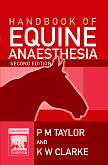|
|
|
| |
 |
|
|

|
-
推薦指數:





|
|
- 內容介紹
|
Handbook of Equine Anaesthesia, 2nd Edition
By Polly Taylor, MA, VetMB, PhD, DVA, MRCVS and Kathy W. Clarke, MA, VetMB, DVA, DVetMed, MRCVS
228 pages
Trim Size 7 3/4 X 9 7/16 in
Copyright 2007
Description
The Handbook of Equine Anaesthesia continues to offer sound practical guidance on all aspects of sedation and anaesthesia in horses. It covers anaesthesia in a logical way from pre-anaesthetic preparation through to induction, maintenance, monitoring and recovery; as well as highlighting any problems and special situations. This second edition now devotes a new chapter to analgesia.
As an easy reference book, it is designed for everyday use by the equine practitioner; from those who anaesthetise many horses daily under theatre conditions, to those who anaesthetise just a few a year. Moreover, Handbook of Equine Anaesthesia is useful for veterinary students, giving them a complete overview of equine anaesthesia.
Reviews
"A fantastic book. Short yet very concise chapters contain a wealth of information, drugs and dose rates are displayed in easy reference tables making it super fast to double check if what you have just drawn into the syringe will be enough or too much!
As this book is a handbook it would be silly to expect it to explain the huge amount of theory behind the subjects of equine anaesthesia, however it is amazing for putting in your back pocket on those long equine surgery nights during rotations to make sure you have vital information with you. I don’t even like equine studies, but I found myself reading pages and pages of the book without realising it, because the information is relayed to the reader in an easy to digest manner.
I can also honestly say that I have already recommended this book to three of my friends who are interested in equine surgery, showed them the book and got the same response each time, which was something along the lines of ‘That is really really good!’
A top notch handbook for a tough subject. Recommended to all."
--- 3rd Year Veterinary Student, Royal Veterinary College, London, UK
"Equine anaesthesia can be one of those areas dreaded by many clinicians, especially if their practice does not undertake many equine surgical procedures. Fear not; the second edition of this handbook again provides an easy reference to the expanding world of equine anaesthesia. The book’s size, and relatively short chapters, may make it less daunting to those who find it easier to send themselves to sleep rather than the horse! The book is still intended for all those who anaesthetise horses, both in a surgical environment and also the occasional ‘field’ anaesthesia.
All in all, this handbook provides the essential drugs and doses required to achieve a safer, smoother and more pain-free anaesthesia. It is not a cumbersome book – it fits easily into the glove box in the car, or on the anaesthetic trolley. It is a must-have book for general and specialised equine practice. Although many sections in the handbook, particularly on analgesia, have been updated, some areas remain unchanged, and potential purchasers considering updating their original version may see limited changes."
--- Reviewed by Nicole Y. Jones for The Veterinary Record, 3rd March 2007
"This book is a must for all veterinary surgeons who carry out equine work. Not only does it cover all aspects of anaesthesia, but also has an excellent chapter on analgesia, sedation and premedication.
Equine nurses will also find this book useful for its chapter on monitoring. Every equine practice should own several copies, and have one tied to the anaesthetic machine. The chart in the front cover, "A routine for cardiopulmonary resuscitation (CPR) after cardiac arrest", should be read before induction by most veterinary anaesthesists, unless they carry our general anaesthetics on a daily basis.
To sum up, this is an excellent book, which should be read - and re-read - at every opportunity. The knowledge within will definitely stop many panic situations and, I suspect, it will save many horses' lives."
--- Reviewed by Graham Duncanson, Veterinary Times, Feb 19, 2007
Key Features
Completely revised and updated, including a new chapter on analgesia
New illustrations
Covers all fundamental and practical aspects of equine anaesthesia
Easy-to-use small format
Written by 2 experienced anaesthetists
Includes both hospital and field anaesthesia
Reviews common practice in Europe and USA
Further reading at end of each chapter
Table of Contents
Preface
Acknowledgements
Chapter 1 Introduction
Chapter 2 Sedation and Premedication
Chapter 3 Intravenous Anesthesia
Chapter 4 Inhalation Anesthesia
Chapter 5 Monitoring
Chapter 6 Analgesia
Chapter 7 Anesthetic Problems
Chapter 8 Anesthesia in Special Situations
Appendix 1 European Law and the Horse as a Food Animal
Index
|
|
|

